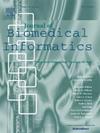评价选择多模态数据融合方法的信息理论方法。
IF 4.5
2区 医学
Q2 COMPUTER SCIENCE, INTERDISCIPLINARY APPLICATIONS
引用次数: 0
摘要
目的:人们对结合放射学、病理学、基因组学和临床数据来提高诊断和预后预测的准确性越来越感兴趣,以实现精准健康。然而,大多数现有的工作选择他们的数据集和建模方法经验和特别的方式。先前的研究提出了四种基于部分信息分解(PID)的度量,以提供对多模态数据交互的理论理解:冗余,每个模态的唯一性和协同。然而,这些指标只在有限的生物医学数据中进行了评估,现有的工作并没有阐明参数选择在计算PID指标时的影响。在这项工作中,我们在更广泛的生物医学数据上评估PID指标,包括临床、放射学、病理学和基因组数据,并提出PID指标的潜在改进。方法:我们将PID指标应用于四个不同队列(数据集)中的七个不同模态对。我们比较和解释在这些多模式队列中产生的PID指标和下游模型性能的趋势。正在评估的下游任务包括预测非小细胞肺癌、前列腺癌和胶质母细胞瘤患者的预后(总生存期或复发)。结果:我们发现,虽然PID指标是信息丰富的,但仅仅依靠这些指标来决定融合方法并不总是产生具有最佳性能的机器学习模型。在七个不同的模态对中,三个差(0%),三个中等(66%-89%),只有一个在PID值与模型性能之间具有完美(100%)一致性。我们提出了PID度量的两个改进(确定最优参数和不确定性估计),并确定了PID度量可以进一步改进的领域。结论:目前的PID指标不足以准确估计多模态数据相互作用,需要改进才能作为可靠的工具。提出改进意见,并对今后的工作提出建议。代码:https://github.com/zhtyolivia/pid-multimodal。本文章由计算机程序翻译,如有差异,请以英文原文为准。

Evaluating an information theoretic approach for selecting multimodal data fusion methods
Objective:
Interest has grown in combining radiology, pathology, genomic, and clinical data to improve the accuracy of diagnostic and prognostic predictions toward precision health. However, most existing works choose their datasets and modeling approaches empirically and in an ad hoc manner. A prior study proposed four partial information decomposition (PID)-based metrics to provide a theoretical understanding of multimodal data interactions: redundancy, uniqueness of each modality, and synergy. However, these metrics have only been evaluated in a limited collection of biomedical data, and the existing work does not elucidate the effect of parameter selection when calculating the PID metrics. In this work, we evaluate PID metrics on a wider range of biomedical data, including clinical, radiology, pathology, and genomic data, and propose potential improvements to the PID metrics.
Methods:
We apply the PID metrics to seven different modality pairs across four distinct cohorts (datasets). We compare and interpret trends in the resulting PID metrics and downstream model performance in these multimodal cohorts. The downstream tasks being evaluated include predicting the prognosis (either overall survival or recurrence) of patients with non-small cell lung cancer, prostate cancer, and glioblastoma.
Results:
We found that, while PID metrics are informative, solely relying on these metrics to decide on a fusion approach does not always yield a machine learning model with optimal performance. Of the seven different modality pairs, three had poor (0%), three had moderate (66%–89%), and only one had perfect (100%) consistency between the PID values and model performance. We propose two improvements to the PID metrics (determining the optimal parameters and uncertainty estimation) and identified areas where PID metrics could be further improved.
Conclusion:
The current PID metrics are not accurate enough for estimating the multimodal data interactions and need to be improved before they can serve as a reliable tool. We propose improvements and provide suggestions for future work. Code: https://github.com/zhtyolivia/pid-multimodal.
求助全文
通过发布文献求助,成功后即可免费获取论文全文。
去求助
来源期刊

Journal of Biomedical Informatics
医学-计算机:跨学科应用
CiteScore
8.90
自引率
6.70%
发文量
243
审稿时长
32 days
期刊介绍:
The Journal of Biomedical Informatics reflects a commitment to high-quality original research papers, reviews, and commentaries in the area of biomedical informatics methodology. Although we publish articles motivated by applications in the biomedical sciences (for example, clinical medicine, health care, population health, and translational bioinformatics), the journal emphasizes reports of new methodologies and techniques that have general applicability and that form the basis for the evolving science of biomedical informatics. Articles on medical devices; evaluations of implemented systems (including clinical trials of information technologies); or papers that provide insight into a biological process, a specific disease, or treatment options would generally be more suitable for publication in other venues. Papers on applications of signal processing and image analysis are often more suitable for biomedical engineering journals or other informatics journals, although we do publish papers that emphasize the information management and knowledge representation/modeling issues that arise in the storage and use of biological signals and images. System descriptions are welcome if they illustrate and substantiate the underlying methodology that is the principal focus of the report and an effort is made to address the generalizability and/or range of application of that methodology. Note also that, given the international nature of JBI, papers that deal with specific languages other than English, or with country-specific health systems or approaches, are acceptable for JBI only if they offer generalizable lessons that are relevant to the broad JBI readership, regardless of their country, language, culture, or health system.
 求助内容:
求助内容: 应助结果提醒方式:
应助结果提醒方式:


